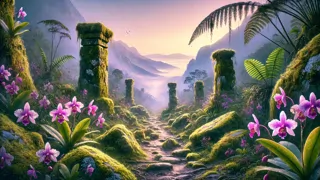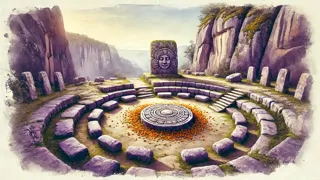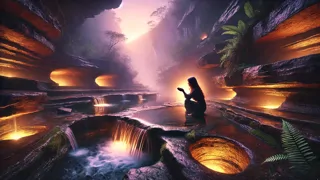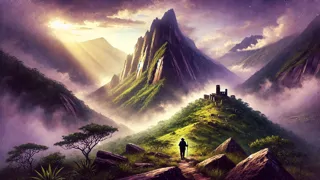Introduction
In the heart of Venezuela’s Andean highlands, where mist winds through jagged peaks and the air brims with ancient whispers, Mount Candelaria rises like a silent sentinel over valleys of emerald forest and rushing rivers. To the people of the nearby village of San Pedro, this sacred mountain holds more than geological grandeur: it is the threshold between the mortal world and a realm of benevolent healing spirits. For centuries, villagers have told stories of lost travelers restored by a gentle breeze carrying the faint scent of orchids and citrus, as if unseen hands stitched body and soul together again. Other tales speak of mysterious lights dancing among the clouds at dawn, guiding those who dare to climb narrow trails toward hidden springs whose waters cure fever and mend broken hearts. Shimmering hummingbirds and vibrant orchids cloak the slopes, while ancient stone markers carved by indigenous ancestors stand sentinel along wind-swept ledges. Our story begins with the steady footsteps of Amara, a young healer, as she departs her adobe cottage with a willow staff, a pouch of powdered roots, and a heart full of resolve. The distant chime of temple bells drifts upward from a weathered stone shrine, and she can almost taste the promise of renewal to come. Yet each step stirs old fears: warnings that the spirits demand respect over offerings, that the mountain’s heartbeat echoes in dreams and visions. As dawn’s first rays gild the ridges and the valley below stirs to life with roosters and chanting villagers, Amara steels herself. The rituals of her ancestors depend on her courage, and the legend of Candelaria’s hidden heart beckons with the hope of healing more than one wounded life.
A Journey to the Sacred Slopes
Amara’s first steps onto the winding trail felt like stepping into another world. The narrow path, carved by centuries of pilgrims, climbed steeply past moss-covered boulders and waterfalls that sang like distant bells. Giant ferns curled at the edges of rocky ledges, and clusters of orchids burst from crevices with delicate petals in shades of pink, lavender, and white. The air was thick with the fragrance of citrus trees hidden among fallen trunks, and the occasional rustle of a bird’s wing sounded like a quiet greeting from unseen guardians. As she walked, Amara recalled the stories her grandmother once whispered by firelight: how the spirits of Candelaria could breathe life back into a broken body, how they taught lessons through dreams, and how they guarded hidden springs with water as pure as crystal.

By midmorning, the trail opened onto a narrow valley where gnarled stone pillars stood like silent sentinels marking an ancient altar. Here, the ground glowed with phosphorescent moss that seemed to pulse with energy at sunrise. Amara knelt and left a small offering of wild cinnamon and yucca root, just as villagers had done for generations. The air shimmered, and for a heartbeat she thought she heard her name carried on the wind. Though no spirit appeared, the earth beneath her felt alive, humming with a vibration that resonated deep in her bones. She closed her eyes, placed a hand on the mossy stone, and listened to the heartbeat of the mountain itself, reminding herself that every step forward was an act of faith.
As the day wore on, clouds drifted in like seekers themselves, weaving among the peaks and casting dappled shadows on the path. Wild hummingbirds flitted around her, darting between bright red heliconias and towering waxpalms. At a narrow switchback overlooking a roaring gorge, Amara paused to rest, drawing water from her goatskin flask and savoring its cool clarity. Nearby, she spotted etched petroglyphs — spirals and figures dancing under a crescent moon — carved by indigenous hands centuries before Spanish conquest. The symbols spoke of balance between earth and sky, death and rebirth, urging her onward. With renewed purpose, she rose and continued her ascent, each footfall echoing a promise that the mountain’s secrets would reveal themselves to those who respected its ancient power.
Echoes of Ancestral Rituals
High above the tree line, where the air thinned and the wind carried whispers of forgotten prayers, Amara found the ruins of an ancestral temple carved into granite cliffs. Massive stone benches formed an open circle around a central altar buried beneath layers of moss and lichen. Petals from marigold garlands, left by past pilgrims, lay scattered like golden embers in the crevices. As she stepped closer, the canyon below echoed with the rush of a hidden waterfall, and the scent of myrrh drifted in from somewhere unseen. She knelt at the altar’s edge and offered a handful of healing herbs — chamomile, coca leaf, and totumo seed. Immediately, the air seemed to shimmer with possibility, and a distant chime resonated through the valley like a bell tolling both welcome and challenge.

Amara recalled the chants her grandmother taught her, each syllable rising and falling like the wind across the mountain: “Candelia, espíritus de veridad, ¡guía mi camino!” She closed her eyes and repeated the incantation softly, letting her breath match the rhythm of those ancient stones. At once, a faint glow appeared around the altar’s edge, drifting upward like dust motes in a shaft of light. She felt warmth at her fingertips, and for a fleeting moment, it seemed that spectral forms — half-seen figures in traditional garb — knelt in reverence around her. Their presence was gentle, like the brush of down feathers, yet charged with a quiet strength that pulsed through the ground.
When she opened her eyes, the spirits were gone, but the altar lay bathed in a pale luminescence. Amara pressed her hand flat against the stone, and a vision blossomed: ancestors gathering around a spring fed by subterranean rivers, their laughter and song carried on the breeze. The air tasted of fresh water and prayers long offered in gratitude. Though the vision faded as clouds scudded across the sun, the mantle of that moment remained — a reminder that the rituals of those who came before her still lived in the very rock and mist of Candelaria. With reverence, she rose and traced the steps her ancestors once took, following faint carvings that led farther upward toward the mountain’s hidden heart.
The Healing Beneath the Mist
As afternoon light waned, a cool mist began to swirl around Amara, blurring the line between earth and sky. She stood before a natural amphitheater of rock ledges, where hundreds of small grottoes carved by wind and water held tiny pools of glistening water. According to legend, these springs were the true heart of Candelaria’s power: each pool reflected a different facet of the mountain’s spirit — clarity, courage, compassion. Amara knelt at the nearest pool and cupped her hands in its crystal surface. The water felt impossibly warm against her palms, and when she drank, she tasted a touch of honey, mint, and something ancient she could not name. Her vision blurred, then cleared, and she saw her own reflection: a young healer whose journey would feed the hopes of every villager waiting below.

From the mist emerged an elderly guide named Narciso, whose eyes shone with the wisdom of countless seasons on the mountain. He wore a cloak of woven llama wool and carried a bundle of sage and palo santo. Without a word, he handed Amara a carved gourd and motioned toward the pools. Together they moved from one spring to the next, offering prayers in low voices. At each pool, Narciso poured a few drops onto the stones, and Amara sprinkled her herbs into the water. The pools glowed softly in response, sending ripples of colored light across the cavern walls. Though she did not see the spirits directly, she felt their presence in every vibration that passed through the stone floor.
Finally, they reached the largest grotto, where a subterranean river gushed from a fissure in the granite. Amara knelt by its edge and bathed her face in its frigid stream. In a single breath, she felt the mountain’s energy flow through her—burning away doubt, weaving new strength into weary muscles, and knitting broken memories into a place of wholeness. When she stood again, Narciso placed a gentle hand on her shoulder and nodded. The healing was complete. Though the sun was nearly set behind distant peaks, the air around them glowed with an inner light. As night fell and stars emerged like jewels above the summit, Amara understood that the mountain’s greatest gift was not magic alone but a deeper trust in the unseen ties between people, nature, and the spirits who guard them.
Conclusion
With dawn breaking once more over the valleys below, Amara retraced her steps down the sacred paths of Candelaria. Though her body felt lighter, as if renewed from the inside, she carried something far more profound: a vision of her people gathering at the mountain’s foot, their hands clasped in shared purpose, their voices rising in song. In San Pedro, she would bring the healing waters and the wisdom of spirits to every hearth and home, weaving old rituals into new hope. As she descended through swirling clouds and sunlit clearings, the mountain seemed to murmur blessings on the breeze — an echo of gratitude for every offering, every prayer, and every heart brave enough to listen. The legend of the Candelaria was no longer simply a story told by firelight; it was a living promise that where nature and memory converge, the power to heal will always endure.



















